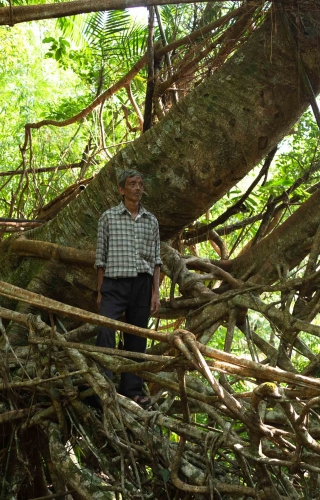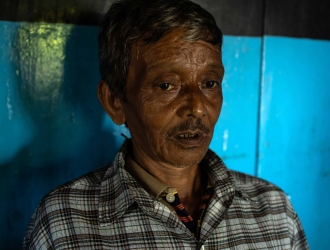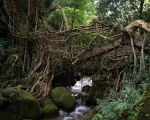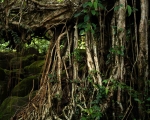The year 2020 has given humanity a timely reminder of the value of nature and the importance of biodiversity conservation; how we, as humans, cannot survive without striking a balance between how we consume natural resources and our incessant pursuit of consumerism. The Covid-19 pandemic has made us all think about our current lifestyle choices, consumption patterns, habitat destruction, carbon footprint, even our eating habits. The origin of the Covid-19 virus from wild animals, and its spread through wet markets has compelled us to voice our concerns and take immediate steps to save our environment for a better future.
In this regard, we have much to learn from India’s tribal populations, who in their habits, lifestyle and cultural practices, have a deep understanding of the ecosystem in which they have lived for hundreds of years. In Meghalaya, the Khasi tribe practices nature worship. For them, the river, forests, trees and mountains are all sacred spaces, which should not be exploited for human needs. Oral folklore narrates stories of spirits in nature who must be appeased for the well-being of the community. To avoid invoking the wrath of these spirits, specially designated forests are maintained as virgin ecosystems, where cutting any tree or foraging for firewood, gathering fallen leaves, or plucking flowers or fruits is taboo. The general term for sacred groves in the Khasi Hills is law kyntang or law lyngdoh, while in the Jaintia Hills they are called khloo blai.
However, it is not only the veneration of nature spirits that ensures Khasi people are committed to protecting the environment. They understand that a healthy ecosystem ultimately protects the community. The forests act as key reservoirs of biodiversity. It helps erosion control, maintenance of water quality, soil conservation, aid in natural dispersal of seeds, maintains species diversity and serve as a natural habitat for local flora and fauna. It is a mutually beneficial relationship. That is what I wanted to explore as I made my way to meet Mr Hally War, a Khasi man in his sixties, at his village in Seij, a small hamlet of only 8–10 households in Sohra civil sub-division, in East Khasi Hills District.
Sohra is the local name for Cherrapunji, which is famed as the wettest place on the planet. Its location on a high plateau acts as a barrier for monsoon clouds blowing in from the Bay of Bengal. As the clouds hit the Khasi Hills, it rises rapidly into the cool temperature of the upper atmosphere, causing the vapours to condense, bringing in torrential rains. The rainwater has cut through the limestone plateau and has created steep gorges and an intricate network of cave systems. The excess rainwater drains through streams, underground cave rivers and spectacular waterfalls to reach the plains below and flows into neighbouring Bangladesh.
Seij village is located about an hour’s drive from Sohra. Mr Hally met me at the parking, from where it is an uphill climb. Even at his advanced age, Mr Hally was climbing the steep stairs with lightning speed. I was barely able to keep pace as we made our way through plantations of kwai (areca nut) trees. I was panting and exhausted by the time we reached his modest home. His wife welcomed me into the guest room. There, I noticed a framed certificate that recognised Mr Hally’s contribution as an architect of root bridges. It was presented to him by Living Bridge Foundation, an organisation dedicated to the preservation of this unique cultural heritage of Meghalaya. There are more than 100 root bridges scattered in the East Khasi Hills and Jaintia Hills; some are still in use, but most are broken, rotted or engulfed by the forest.
Root bridges are an example of how indigenous knowledge systems evolve to find a solution to problems using locally available resources. No one knows when or how the concept of root bridges started. In the monsoon season, villagers had to cross gushing streams, and given the rapid water flow, it was a dangerous task. It was observed that the Ficus Elastica plant—a species of the fig genus—grew strong roots in the rocky soil which could be manipulated in a certain direction. The elastic roots were stretched to cross streams and, over time, as they grew older and thicker, they could carry the weight of a human. In this way, root bridges became an extended part of a living tree, which make them ‘living’ root bridges. This intangible skill has been passed down through generations within families who have extensive knowledge of the local climate, terrain, flora, fauna and geography.
To a visitor like me, root bridges are nothing short of bioengineering marvels. In the vicinity of Seij are two root bridges. The newer bridge, Ummunoi, is still in the making; Mr Hally supervises and works on it every day. Though work on the bridge has been ongoing for decades, it will take several more decades for the bridge to be functional. While making a root bridge, one has to adjust to nature’s pace. When I visited Ummunoi bridge, it was closed for visitors. Mr Hally said it is still not ready to carry multiple people. However, I was allowed to walk barefoot on the bridge and experience this architectural marvel closely. Mr Hally has been experimenting with its shape and utility. The work requires both immense skill and patience. He is helped in this work by his son, Mark, who is keen to build a bridge on his own. He has been working on a diagonal extension over the bridge which will give tourists a higher view. It was gratifying to see the knowledge being carried forward by the next generation who are keen to ensure that the living root bridges of Meghalaya continue to live into the future.
Close by there is another older root bridge called Umkar. These two bridges are away from the tourist circuit, which focuses on the famous ‘double decker’ root bridge at Nongriat. Mr Hally wishes that in the future these root bridges would encourage tourism in Seij and the surrounding villages.
Mr Hally splits his time between working on the bridges and working on his plantation. As a farmer, he grows betel leaves, pepper, areca nut and other crops, which is his only source of income. He said he has been making root bridges since he was a child. It is part of his daily life. He doesn’t see it as a special skill or a task separate from his work on his plantation. Both require knowledge of the environment and its practical application. He does it from his own passion and love, which comes with a certain upbringing and values. For building a root bridge, one must have skills to tie the roots, visualise how they will intertwine and become robust with each passing year. Once strong enough, a root bridge can be used by humans for 300 to 400 years, while also sustaining other life forms within its ecosystem.
I wonder, in today’s day and age, when a road can be built overnight and footbridges are made from concrete, what is the need for building a living root bridge that will take a lifetime to complete? Why would someone invest so much time and energy into something that he wouldn’t even be around to enjoy? I asked Mr Hally what motivated him. ‘It is a gift for the next generation,’ he said. In today’s fast-paced world, there aren’t many people who believe in working slow, one day at a time, to create something for posterity, and therein lies the beauty of these living root bridges of Meghalaya.
This photo-essay has been created as part of the Sahapedia Frames Photography Grant, supported by CSR funding from IndusInd Bank.

















